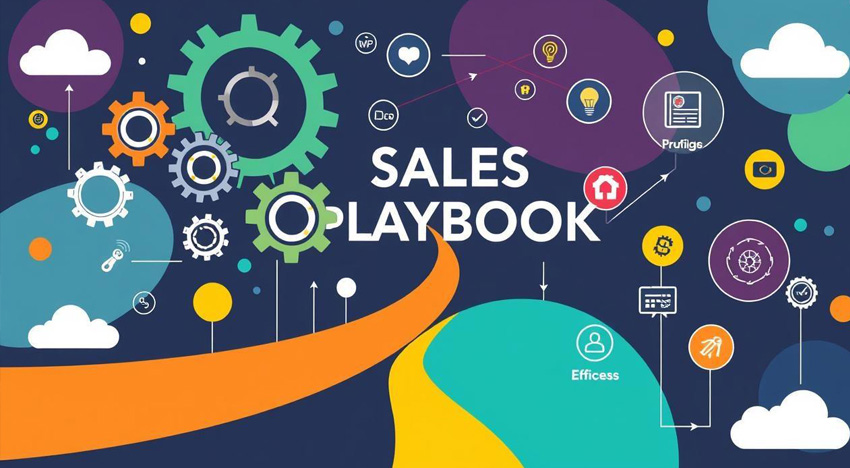Sales playbooks are key for better team performance. They unify processes and make communication clear. Using them can boost team performance by as much as 30%. Companies with clear processes also see big benefits. They witness a 28% cut in how long sales take. Plus, they enjoy a 10% revenue increase every year, unlike those without clear processes.
Implementing a sales playbook can lift win rates by 15%. Also, 62% of teams with playbooks see improved organization alignment. This shows how vital these guides are. They make sales efforts uniform by sharing best practices and tools. Thus, sales playbooks are crucial for boosting sales productivity and team efficiency.
A solid sales playbook can also make training new hires 50% faster. This helps newcomers start contributing quickly. When sales reps have clear guidelines, they feel more confident. This leads to success and aligns everyone’s efforts toward shared goals.
Key Takeaways
- Sales playbooks can increase sales productivity by 34%.
- Implementing playbooks correlates with a 15% improvement in win rates.
- Organizations experience a 10% growth in revenue year-over-year with playbooks.
- Sales teams using playbooks report better alignment across the organization.
- Onboarding time for new hires can be reduced by 50% with playbooks.
What is a Sales Playbook?
A sales playbook helps sales leaders and teams perform better and follow effective strategies. It’s a detailed guide that unifies the team’s efforts, making sure everyone knows what to do to be successful.

Definition and Purpose
A sales playbook is like a playbook for the team but for sales. It contains tactics, methods, and the best sales practices. These are tailored to help teams achieve their sales goals efficiently. The main goal of a sales playbook is to make sales processes smooth, boost productivity, and cut down the time it takes to train new salespeople.
Companies that have a set sales process see big improvements in how well they perform and in their closing rates. Using a playbook helps avoid mistakes and keeps team members working well together. Companies with a playbook see up to a 15% boost in productivity and can have a 28% higher increase in revenue than those without one.
Key Components of a Sales Playbook
A solid sales playbook contains important parts that help improve performance:
- Target Customer Profiles: Gives detailed info on the ideal customers and what they need.
- Stages of the Sales Process: Offers clear steps for each phase, cutting down the time to close deals.
- Sales Methodologies: Shares proven ways to deal with objections successfully in 75-85% of situations.
- Tools and Technologies: Lists the essential tools needed, from CRM to data platforms.
- Best Practices: Provides strategies for ongoing improvement, giving teams an edge.
Organizations that update their playbooks regularly, about 60% do this every quarter, stay in tune with market shifts. Regular updates give teams a strong base, leading to a 40% boost in collaboration and productivity.
Benefits of Using Sales Playbooks
Sales playbooks boost your team’s efficiency. They are key to teamwork success and make sure everyone follows the same steps. With clear guidelines, sales playbooks bring consistent, great results. Here’s how they help:
Improved Team Performance
Sales playbooks align team members with company goals. Firms with strong playbooks are 33% more likely to perform well. This keeps reps focused on selling, not searching for info. Resulting in more sales and improved teamwork success.
Standardized playbooks also mean a 33% better chance at closing deals. This boosts overall team performance significantly.
Increased Consistency in Sales Efforts
Sales playbooks ensure uniform sales strategies. This pushes win rates above 50% for many firms. It’s about making sales efforts consistent and clear. That way, all sales managers and reps are on the same page. This approach speeds up deal closures and raises effectiveness.
Enhanced Training for New Hires
Bringing in new staff is easier with sales playbooks. They cut down training time by up to 25%. These playbooks offer step-by-step guides, reducing the learning curve for new sales reps to understand them by 40%. Plus, they lead to a 30% jump in sales productivity. This shows how vital playbooks are for a fast-learning and skilled sales team.

| Statistic | Impact |
| 33% more likely to be high performers | Companies with defined sales playbooks |
| 50% win rates | Companies with established sales playbooks |
| 25% reduced onboarding time | New hires using comprehensive sales playbooks |
| 40% faster ramp-up for new hires | Immediate access to resources |
| 30% improvement in sales productivity | Organizations utilizing sales playbooks |
How Sales Playbooks Drive Process Standardization
Sales playbooks are key in making sure sales teams do things the same way. They help each sales rep follow a standard approach. This improves sales productivity by giving everyone a clear plan.
By teaching effective processes and best activities, playbooks make sales teams more consistent and efficient.
Streamlined Communication and Collaboration
Sales playbooks boost team communication and collaboration. They make it easy for team members to share info and strategies. This creates a team where everyone knows the plan, improving sales work.

Sales playbooks also make sure all sales reps talk to clients in the same way. This makes customer experiences better and helps close more deals.
Ensuring Compliance and Best Practices
Sales playbooks are crucial for following rules inside and outside the company. They guide sales reps on how to stick to best practices. This matters a lot in regulated industries, where breaking rules can cost a lot.
Playbooks also make the whole sales organization work better. They can lead to more sales and quicker deals. This happens because everyone is working from the same plan.
| Metric | Benefit |
| Conversion Rate Improvement | 20% |
| Sales Cycle Reduction | 25-30% |
| Onboarding Efficiency | 50% faster |
| Win Rate Improvement | 15-40% |
| Sales Forecast Accuracy | 30% improved accuracy |
Using sales playbooks to standardize processes helps a lot. It makes sales teams better, improves communication, and keeps practices in line. This leads to a team that achieves its goals regularly and successfully.
Steps to Create an Effective Sales Playbook
Making an effective sales playbook is key for better sales strategy and team performance. By following a systematic method, you ensure that creating your sales playbook is complete, doable, and perfectly suits your sales team’s needs.
Conducting a Needs Assessment
Start by doing a deep needs assessment to find where your sales tactics might be lacking. Look into sales numbers, what customers have said, and performance stats. This first step helps point out the pain points where improvements are needed, giving a clear path for the playbook’s content.
It’s important to note that companies with written sales processes get 18% more revenue than those without one. So, a needs assessment isn’t just good to have; it’s crucial for earning more.
Gathering Input from Your Sales Team
One top method in making a sales playbook is to get your sales team’s feedback. Including your sales team’s success in this process makes sure the playbook tackles real-life challenges and strategies. Statistics show that when sales teams are involved in creating the playbook, there is a 60% higher follow-through rate.
This teamwork boosts team performance and makes sure the playbook is used correctly.
Structuring the Content Effectively
Correctly organizing the playbook’s content is key to its success. Your playbook must cover important parts like buyer personas, sales stages, and top sales tactics. For example, sales groups who detail buyer personas handle customer objections 60% better. Also, following a set sales process can bump up conversion rates by 20%.
| Aspect | Description | Impact |
| Buyer Personas | Detailed descriptions of customer types | 60% more effective in addressing objections |
| Sales Stages | Clearly defined steps in the sales process | 20% increase in conversion rates |
| Sales Strategies | Tactics to approach and close sales | 33% higher win rates |
| Training Modules | Materials for onboarding and skill development | 50% faster ramp-up times |
Adding these parts makes sure your playbook is not just a manual but a strong tool to boost team performance and sales effectiveness. Companies that use playbooks for sales training can see a 40% better performance in new sales reps. This shows how important a well-made playbook is.
Essential Elements of a Sales Playbook
Creating a strong sales playbook boosts performance and sales productivity. It should include detailed buyer personas, a defined sales process, and tools and resources for the team. These elements help in supporting your sales team effectively.
Buyer Personas and Their Needs
Knowing your buyer personas is key to a successful sales strategy. It involves understanding their problems, who they are, and their buying habits. This knowledge lets your sales team craft messages that meet their specific needs.
By using buyer personas, your sales team can better connect with potential clients. This leads to better performance across all sales efforts.

Sales Process and Stages
A clear sales process helps guide your sales reps through each deal stage. These stages include Prospecting, Discovery/Demo, Solutions Engineering/Proposal, and Customer/Client Success & Renewal. This structure makes activities efficient and keeps outreach consistent, improving win rates.
Teams following a standard process can see up to a 40% rise in sales productivity. This consistency is key to success.
Tools and Resources for the Sales Team
It’s vital to equip your sales team with necessary tools and resources. These could be CRM software, sales enablement platforms, and communication templates. Such resources save time and enhance interactions with prospects, boosting performance.
Sales execs spend a lot of time searching for information each week. Organized tools can cut this time significantly. This efficiency leads to better productivity and more revenue.
Tips for Optimizing Sales Playbooks
Keeping your sales playbooks up-to-date and listening to user feedback are key. These steps help standardize processes and improve sales.
Regularly Updating Content
Review your sales playbooks every quarter, especially in quick-moving sales fields. Updates are crucial for staying in line with customer needs and sales targets. This shows that sales methods often change, needing regular reviews.
Use webinars and workshops to keep your sales team in the loop about playbook changes. This training is vital for their success.

Enhance your sales playbooks by using customer feedback, sales data, and research on competitors. Keeping your playbook current with sales trends and market changes is crucial. This prepares your team to tackle new challenges and seize opportunities.
| Key Performance Indicator (KPI) | Why It’s Important |
| Win Rate | Shows how many deals are won, reflecting on sales success. |
| Conversion Rates | Tells how well leads turn into customers, showing efficiency. |
| Average Deal Size | Helps track revenue growth by looking at the size of deals. |
| Sales Cycle Length | Shows the time needed to close a deal, indicating process speed. |
Incorporating Feedback from Users
It’s crucial to use your sales team’s feedback to make playbooks useful. Organizations that do this see a 25% rise in how much the playbooks are used. High-performing teams also look at playbook analytics to find places to get better, shifting team strategies.
Collect feedback through daily metric checks and see how engaged people are after training. You can also ask for feedback in meetings or through anonymous surveys. This feedback is vital for making your content match the current sales scene and what the team needs. It helps build a culture where everyone keeps improving.
How to Implement Sales Playbooks Successfully
An effective sales playbook launch needs detailed training and clear rules. A plan helps your team know how to use the sales playbook templates to boost consistency and performance. They learn about the playbook’s content and use methods in training. This provides a base for standard processes and regular use.
Training Your Team on the Playbook
Starting strong means thorough training. Hold training sessions to show your sales team the playbook. They’ll learn about target audience, buyer types, the sales process, and how to respond to objections. A well-made sales playbook makes the sales team more effective by guiding them in various situations.
Training aims to make sure each member is comfortable with the playbook. This helps them follow standard methods. Well-trained teams not only understand better but also deliver a consistent message, improving teamwork. Effective training can raise employee efficiency by up to 11%.

Setting Clear Expectations for Usage
Setting clear rules for playbook use is as important as training. Define when and how the playbook should be used. This might be for daily sales activities, finding prospects, or talking to clients. Teams with a standard playbook work better together and avoid mistakes with clients.
Managers need to watch how well these rules are followed and give feedback. Underlining the full value proposition of a well-organized approach ensures everyone sticks to the rules. Companies with precise playbooks often see faster decision-making and more sales completed.
- Initial training sessions to cover all aspects of the playbook.
- Regular reinforcement sessions to ensure continuous alignment.
- Clear guidelines on daily sales routines and client interaction.
- Consistent monitoring and feedback to maintain adherence.
Focusing on detailed training and clear rules maximizes your company’s sales strategy and playbook’s impact. It leads to better team performance all around.
Leveraging Technology for Sales Playbooks
Modern technology can boost sales productivity and make processes smoother. With CRM systems and digital tools, sales playbooks become more dynamic and easier to use. This helps your sales team perform better.
Using CRM Systems for Access and Integration
Customer Relationship Management (CRM) systems are key for quick data access and integration. Embedding your playbook in your CRM allows sales reps to easily find information when talking to prospects. This method increases productivity and keeps data tidy in one place.
Using integrated playbooks in CRMs reduces time spent on searching for content by up to 15%. This gives reps more time to focus on leads.

Digital Tools for Collaboration and Updates
Digital tools help with teamwork and keeping things up-to-date. Cloud platforms let teams work together on the playbook, sharing feedback quickly. Automation tools update materials right away, cutting down delays significantly.
Teams using these tools see deals get 43% bigger on average. This shows how tech can make a big impact in sales playbooks.
Including visuals and easy navigation in your playbook helps a lot too. These things can make your team remember information 50% better, making them more sharp and confident. Because of this, companies with upgraded playbooks are 33% more likely to hit their revenue goals.
Measuring the Impact of Sales Playbooks
It’s vital to know how well sales playbooks work for better outcomes. This means watching key performance markers (KPIs) and getting detailed feedback from your sales crew.
Key Performance Indicators to Track
Checking KPIs helps us see how good our sales plans are doing.
Here’s what metrics to watch:
- Win Rates: Firms with sales playbooks see up to 15% better win rates.
- Sales Quotas: Reps that use a playbook get 20% higher sales quotas on average.
- Productivity: Playbooks and sales tools raise sales productivity by 20%.
- Deal Closing Speed: 65% of leaders think playbooks help close deals faster.

Gathering Feedback from the Sales Team
Getting your sales team’s input regularly is key for improving. Talking with your sales team members helps understand how the playbook works out there and what needs work.
Think about these methods:
- Periodic Surveys: Use surveys to see what the team thinks about the playbook’s effectiveness.
- Regular Meetings: Have meetings to talk about the playbook’s effect and find ways to make it better.
- Performance Data: Systematically look at sales data to spot trends and areas to improve.
By taking these steps, you make sure your company strategy, sales tactics and efforts to get better are on point and can change with the market.
Real-Life Case Studies of Successful Playbook Implementation
Sales playbooks significantly boost teamwork, success stories and sales productivity. Companies using them well see big improvements in their numbers and employee training. Let’s check out two real-life examples of these successes.

Boosting Performance Metrics
Company A, in the financial services, saw big gains after using a detailed sales playbook.
They saw:
- Win rates jumped by up to 25%
- Sales cycles shortened by 30%
- More leads became paying customers
The playbook’s guidelines helped the sales team do better. They got more customers and made more sales. They also kept an eye on lead metrics to keep improving sales funnel.
Enhancing New Hire Training
Company B, a big name in tech, used a customized playbook for training newcomers.
They achieved:
- New employee training time was cut by half
- Training consistency led to uniform sales methods
The playbook covered everything new hires needed, like customer info, sales materials and market trends. It helped raise sales productivity and paved the way for their success.
| Metric | Improvement Percentage |
| Win Rates | 25% |
| Sales Cycle Length | -30% |
| Ramp-Up Time | -50% |
These examples show how well-crafted playbooks lift teamwork success and sales productivity.
Common Misconceptions About Sales Playbooks
Sales playbooks are crucial for executing effective sales strategies. They vastly improve team performance. However, myths about sales playbooks can stop their use and effectiveness.
Playbooks Are Only for New Teams
It’s wrong to think that sales playbooks are only for new teams. Yes, they help new hires. But they also offer more.
For seasoned teams, playbooks mean everyone follows the same selling process. This consistency boosts team performance. These guidelines help even the pros get better, aligning them with the best practices.
Sales Playbooks Limit Seller Creativity
Many believe that sales playbooks limit creativity. That’s not true. Playbooks provide a base structure, not constraints.
They let salespeople be creative within a clear framework. This means they can adapt to meet customer needs better. Such a balance between guidelines and freedom boosts sales strategies and team results.
Companies that keep their sales playbooks updated do well. They reflect current market trends and customer behavior. This not only meets short-term goals but also ensures long-term growth. With a clear sales process, businesses see higher revenue, better lead retention, and accurate sales forecasts.
FAQ
What is a Sales Playbook?
A sales playbook is a guide. It helps sales teams win and engage customers effectively. It features strategies, customer profiles, and the sales process. It also includes tools and tech to make sales smooth and boost productivity.
How do Sales Playbooks improve team performance?
Sales playbooks boost team work by keeping everyone on the same page. They ensure consistent sales efforts. They are also great for training new new team members clearly and thoroughly.
How do Sales Playbooks drive process standardization?
They make methods and processes uniform by compiling them in one place. This helps everyone follow best practices and regulations. It also makes team communication and work together easier.
What are the key components of a Sales Playbook?
Important parts of a sales playbook include buyer details, a defined sales process, and helpful tools. These support the team daily and in dealing with clients.
What are the steps to create an effective Sales Playbook?
To make a good sales playbook, first, figure out what is missing. Then, collect team insights to keep it relevant. Finally, organize it with buyer information, sales steps, and strategies to measure success.
How should a Sales Playbook be implemented successfully?
For a playbook to work well, train the team on its contents. Set clear rules for its use. Make sure everyone sticks to the practices in it.
How can technology be leveraged for Sales Playbooks?
Use CRM systems to gather customer info easily. Digital tools can also help the team work together better. They keep the playbook updated in real-time, too.
What are some benefits of using Sales Playbooks?
Benefits include better team work, more uniform sales effort, and improved training. They also help in keeping everyone aligned and in following best practices.
How often should Sales Playbooks be updated?
Update them often to match new sales methods and market conditions. Use team feedback to make needed changes. This keeps the playbook current and useful.
Why are Sales Playbooks beneficial for new hires?
They give new members a clear and detailed guide. This helps in training them well. It ensures they fit right into the whole sales team structure and its goals.
Do Sales Playbooks limit seller creativity?
No, they actually provide a base that encourages unity and creativity. They allow for creative customer approach within set guidelines.
What are some key performance indicators to measure the impact of Sales Playbooks?
Look at win rates, how long sales take, and how happy customers are. Getting team feedback also shows how well the playbook works and where it can improve.
What are some future trends in Sales Playbooks?
Trends point to using AI and automation to make sales smoother. There’s also a shift to custom playbooks. This addresses each team member’s unique needs, boosting effectiveness and satisfaction.
References
- Sales Playbook: Best Examples & Template – https://www.pipedrive.com/en/blog/sales-playbook
- How to Build a Sales Playbook From Strategy to Execution | Mailchimp – https://mailchimp.com/resources/sales-playbook/
- Unlocking Success with Sales Playbooks – https://hygenixinc.com/unlocking-success-sales-playbooks
- What is a Sales Playbook and Why is it Important? – Furza – https://furza.co.uk/what-is-a-sales-playbook-and-why-is-it-important/
- What is a Sales Playbook? (Explained With Examples) – https://www.breakcold.com/nl/explain/sales-playbook
- What is a sales playbook and how to create one – https://capsulecrm.com/blog/sales-playbook/
- Sales Playbooks 101: Best Practices & Strategies | Seismic – https://seismic.com/enablement-explainers/sales-playbooks-101/
- Building Sales Playbooks That Enable Winning Sales Plays – https://demodesk.com/resources-guides/sales-playbook-guide
- How to: Implement Sales Playbooks (and why they’re valuable) — Anderson-Hill – https://www.anderson-hill.co/blogs/how-to-implement-sales-playbooks
- Sales Playbooks: Essential Tactics for Boosting Team Performance – https://www.graygroupintl.com/blog/sales-playbooks
- Understanding the Sales Playbook: What It Is and How to Create One for Your Business | Alore – https://www.alore.io/blog/sales-playbook
- Sales Playbook – https://www.useposeidon.com/glossary/sales-playbook
- Creating an Effective Sales Playbook: Strategies and Implementation – https://www.ringy.com/articles/sales-playbook
- The Ultimate Guide to Creating an Effective Sales Playbook | 6sense – https://6sense.com/blog/sales-playbook/
- Four Components of Every Great Sales Playbook – https://skaled.com/insights/what-to-include-sales-playbook/
- 7 Essentials for a Winning Sales Playbook – Peer Sales Agency – https://peersalesagency.com/7-essentials-for-a-winning-sales-playbook/
- How to Create a Winning Sales Playbook [Examples & Templates] – https://www.yesware.com/blog/sales-playbook/
- How do you update and optimize your sales playbook over time? – https://www.linkedin.com/advice/0/how-do-you-update-optimize-your-sales-playbook
- 10 Practical Strategies to Improve Sales Performance & Close Deals – https://www.highspot.com/blog/improve-sales-performance/
- 7 Key Components Of A Successful Sales Playbook – https://fireflies.ai/blog/sales-playbook/
- 7 Sales Playbooks to Help You Score in the Final Quarter – https://blog.hubspot.com/sales/sales-playbook
- Creating a Sales Playbook: Step-by-Step Guide – Outbound Master – https://outboundmaster.com/creating-a-sales-playbook-step-by-step-guide/
- Building the Perfect Sales Playbook | Seismic – https://seismic.com/blog/perfect-sales-playbook/
- The beauty of the sales playbook: How to convert effort into performance – https://www.superoffice.com/news/insights/beauty-of-sales-playbook/
- Sales Playbook: Your Guide to Sales Success – https://www.getcensus.com/ops_glossary/sales-playbook-your-guide-to-sales-success
- Q&A: How to Build Data-Backed Sales Playbooks – https://www.ibisworld.com/blog/data-backed-sales-playbook/1/1127/
- Decoding the Enigma: Demystifying the Sales Playbook – https://liveguru.io/blog/unveiling-the-mystery-what-is-a-sales-playbook?hs_amp=true
- The One-Two Punch: Virtual Selling and Sales Playbooks – https://www.bain.com/insights/sales-playbooks-virtual-selling-tech-report-2020/
- Sales Process: Your Complete Guide – https://www.revenue.io/blog/sales-process-your-complete-guide
- Power of B2B Sales Playbooks: Revolutionizing Strategies for Success – https://www.b2brocket.ai/blog-posts/b2b-sales-and-the-importance-of-b2b-sales-playbooks
- How to build your winning 2023 SaaS sales playbook | Demoleap – https://www.demoleap.com/post/how-to-build-your-winning-2023-sales-playbook-a-comprehensive-guide
- How HubSpot Sales Playbooks Can Maximise Efficiency – https://www.bee.digital/en/blog/hubspot-sales-playbooks







